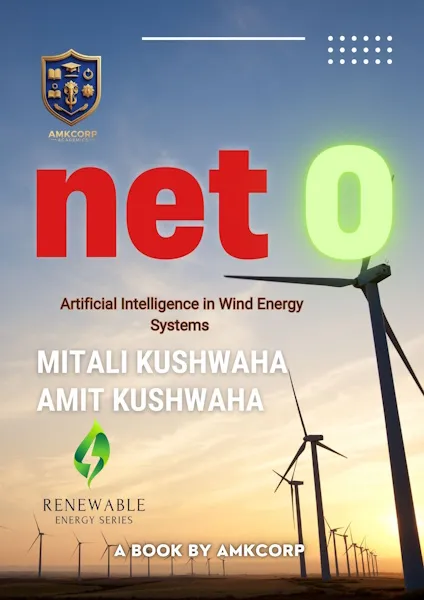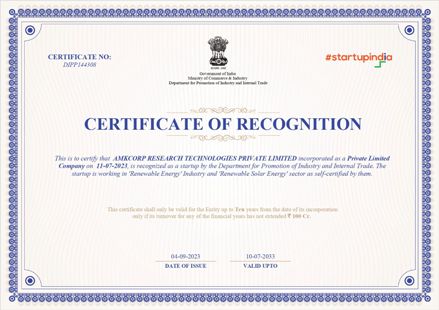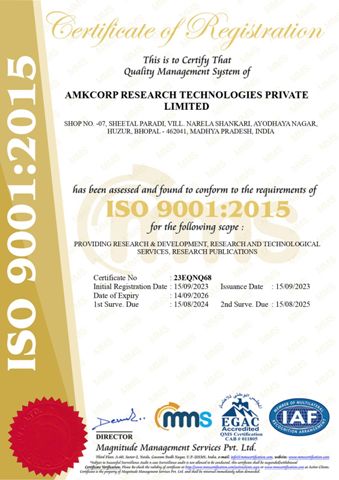

₹ 2499.00
$ 220.00

NET 0
ARTIFICIAL INTELLIGENCE IN WIND ENERGY SYSTEMS
AUTHOR(S) -
MITALI KUSHWAHA, AMIT KUSHWAHA
DOI – 10.61909/AMKEDTB092543
Genre/Subject – Wind Energy, Energy Systems, Computer Science, AI, Book code – AMKEDTB092543 pgs:
ISBN(P) – 978-93-6556-413-6
Published – 29/11/2025
ISBN(E) – 978-93-6556-272-9
Published – 15/09/2025
AUTHOR(S)

AMIT KUSHWAHA
With an impressive track record spanning over 15 years, Mr. Amit Kumar Kushwaha stands as a paragon of experience and innovation. Armed with a Master’s in Thermal Engineering and a Bachelor’s in Automobile Engineering, his expertise embodies a perfect synergy of technical brilliance and creative thinking. As the driving force behind his company, Amit’s dynamic leadership propels his team towards excellence. Beyond the boardroom, his fervent commitment to academia and research shines brightly. Active participation in scholarly pursuits reflects his dedication to ongoing learning and intellectual growth.

MITALI KUSHWAHA
With an illustrious career spanning 17 years, Mitali is a dynamic leader who marries her extensive expertise with an unwavering passion for innovation. Armed with a Master’s in Energy, Environment, and Management Engineering, along with a Bachelor’s in Electrical and Electronics Engineering, she represents the perfect fusion of technical prowess and environmental consciousness. As the visionary force behind her company, Mitali’s leadership fuels its journey towards sustainable excellence. Beyond her corporate role, she continues to actively contribute to academia and research, reflecting her commitment to advancing knowledge.
ABOUT BOOK / ABSTRACT
NET 0 – Artificial Intelligence in Wind Energy Systems is a groundbreaking exploration of how AI and data-driven intelligence are transforming the global wind energy landscape and accelerating the world’s journey toward net-zero emissions.
This book bridges academic research with real-world innovation, offering readers a detailed yet accessible understanding of how technologies like machine learning, predictive analytics, and deep learning are revolutionizing every stage of wind energy — from site selection and turbine design to predictive maintenance, power forecasting, and smart grid integration.
Through 22 comprehensive chapters, NET 0 covers the full spectrum of AI applications in wind systems — including performance monitoring, energy storage optimization, offshore wind solutions, and ethical considerations. It combines technical insights, case studies, and future-ready perspectives to show how intelligent automation can make renewable energy more efficient, affordable, and sustainable.
Whether you are a student, researcher, energy engineer, policymaker, or sustainability enthusiast, this book serves as both a reference and inspiration — guiding you through the technologies shaping the next era of clean power.
NET 0 is not just a book — it’s a vision for a future where artificial intelligence empowers humanity to achieve true energy independence and environmental harmony.
CHAPTERS
PART 1
Chapter 1: Introduction to Wind Energy and AI
1.1 Overview of Wind Energy
1.2 The Role of AI in Renewable Energy
1.3 How AI Integrates with Wind Energy Systems
1.4 History and Evolution of Wind Energy Technologies
1.5 The Need for Innovation in Wind Power
1.6 Market Growth and Trends in Wind Energy
1.7 Key Benefits of AI in Wind Power Systems
Chapter 2: The Fundamentals of Wind Energy Systems
2.1 Components of a Wind Turbine
2.2 Types of Wind Turbines
2.3 Wind Energy Conversion Process
2.4 Energy Production and Efficiency Metrics
2.5 Environmental Impact of Wind Energy
2.6 Site Selection for Wind Farms
2.7 Technological Challenges in Wind Energy Systems
2.8 Performance Metrics of Wind Energy Systems
Chapter 3: AI Techniques for Wind Energy Optimization
3.1 Machine Learning Algorithms in Wind Energy
3.2 Predictive Analytics for Wind Turbine Performance
3.3 AI for Predictive Maintenance of Turbines
3.4 Optimization of Turbine Placement Using AI
3.5 Wind Resource Assessment with AI
3.6 AI in Load Forecasting and Energy Management
3.7 AI-Driven Control Systems for Wind Farms
3.8 Real-time Data Processing for Wind Energy Systems
Chapter 4: AI-Powered Predictive Maintenance in Wind Turbines
4.1 Introduction to Predictive Maintenance
4.2 Vibration Monitoring and AI Algorithms
4.3 Using AI for Fault Detection and Diagnosis
4.4 AI for Wear and Tear Analysis in Turbines
4.5 Remote Monitoring of Turbine Health with AI
4.6 Maintenance Scheduling Using AI Predictions
Chapter 5: Data Acquisition and Management for Wind Energy
5.1 Importance of Data in Wind Energy Systems
5.2 Sensor Networks for Wind Farms
5.3 Real-time Data Collection and Monitoring
5.4 Data Storage and Cloud Solutions
5.5 Big Data Analytics in Wind Energy
5.6 Managing Large Datasets in Wind Farms
5.7 Data Security and Privacy in Wind Energy
5.8 Data Integration and Interoperability
Chapter 6: AI for Wind Forecasting and Power Generation Prediction
6.1 Importance of Accurate Wind Forecasting
6.2 AI Models for Wind Speed and Direction Forecasting
6.3 Time-Series Data Analysis for Wind Prediction
6.4 Deep Learning in Wind Forecasting
6.5 Enhancing Power Generation Predictions with AI
6.6 Case Studies of AI in Wind Power Forecasting
6.7 Limitations of AI in Wind Prediction
6.8 Future Trends in Wind Forecasting with AI
Chapter 7: Optimization of Wind Farm Layouts with AI
7.1 Importance of Wind Farm Layouts
7.2 AI for Site Suitability Analysis
7.3 Optimization Algorithms for Turbine Spacing
7.4 Minimizing Wake Effects Using AI
7.5 AI for Turbine Positioning in Complex Terrain
7.6 Computational Models for Wind Farm Layout
7.7 Case Study: AI in Wind Farm Layout Optimization
Chapter 8: AI in Wind Turbine Design and Innovation
8.1 Role of AI in Turbine Design
8.2 Generative Design for Turbine Components
8.3 AI in Blade Design and Material Selection
8.4 Aerodynamics and Performance Enhancements with AI
8.5 Smart Sensors for Monitoring Turbine Design Performance
8.6 Innovations in Turbine Control Systems with AI
8.7 AI in Reducing Turbine Maintenance Costs
8.8 Future Trends in Turbine Design Using AI
Chapter 9: AI for Energy Storage Solutions in Wind Energy
9.1 Importance of Energy Storage for Wind Energy
9.2 AI in Battery Storage Management
9.3 Smart Grid Integration with Wind Power
9.4 Load Forecasting and Energy Distribution
9.5 AI for Energy Storage Optimization
9.6 Predicting Storage System Performance with AI
9.7 Grid Stability and Demand-Supply Management
Chapter 10: AI for Wind Energy Integration with Smart Grids
10.1 Basics of Smart Grids and Wind Energy Integration
10.2 AI for Real-time Monitoring and Control
10.3 Grid Load Balancing with AI
10.4 AI in Demand-Response Systems for Wind Energy
10.5 Virtual Power Plants and AI
10.6 AI for Energy Trading and Market Forecasting
10.7 Challenges in Smart Grid Integration with Wind Energy
10.8 Future Developments in AI for Grid Integration
PART 2
Chapter 11: AI in Wind Farm Performance Monitoring
11.1 Importance of Performance Monitoring in Wind Farms
11.2 AI for Real-time Performance Analysis
11.3 Predicting and Preventing Downtime with AI
11.4 Energy Yield Forecasting Using AI
11.5 AI Models for Load and Turbine Performance
11.6 Anomaly Detection in Wind Farm Operations
11.7 Visualization Tools for Performance Monitoring
Chapter 12: AI for Wind Energy Policy and Decision Support
12.1 Role of AI in Policy Making for Wind Energy
12.2 Decision Support Systems (DSS) for Wind Energy Planning
12.3 AI in Regulatory Compliance and Standards
12.4 Impact of AI on Wind Energy Market Dynamics
12.5 Optimizing Policy with AI Insights
12.6 AI for Risk Management in Wind Energy
12.7 Environmental and Economic Considerations
12.8 Future of AI in Wind Energy Policy Making
Chapter 13: AI in Wind Energy for Developing Countries
13.1 Wind Energy Potential in Developing Regions
13.2 Cost-effective Wind Power Solutions Using AI
13.3 AI for Small-scale Wind Turbine Design
13.4 Community-based Wind Energy Projects
13.5 Energy Access and AI Solutions for Rural Areas
13.6 Challenges of Implementing AI in Developing Countries
13.7 Collaborative Models for Wind Energy Growth
13.8 Future Opportunities in Wind Energy for Emerging Markets
Chapter 14: AI in Wind Energy for Offshore Applications
14.1 Offshore Wind Energy: Opportunities and Challenges
14.2 AI in Offshore Wind Farm Site Selection
14.3 Optimizing Offshore Turbine Operation with AI
14.4 AI in Underwater Energy Storage and Distribution
14.5 AI-Driven Maintenance for Offshore Wind Farms
14.6 Remote Monitoring for Offshore Wind Farms
Chapter 15: AI for Wind Turbine Control Systems
15.1 Control Systems in Wind Turbines
15.2 AI for Adaptive Turbine Control
15.3 Advanced Control Algorithms in Turbines
15.4 Energy Efficiency Through AI-Based Control
15.5 AI in Pitch Control and Yaw Mechanisms
15.6 Real-Time Control Systems Using AI
15.7 Case Studies of AI Control Systems in Wind Turbines
15.8 Future Developments in AI for Turbine Control
Chapter 16: AI-Driven Wind Energy Market Forecasting
16.1 Energy Market Dynamics and Wind Energy
16.2 AI for Demand and Supply Forecasting
16.3 Predicting Wind Power Generation Trends
16.4 Energy Price Prediction Using AI
16.5 AI for Carbon Trading and Emission Reduction
16.6 AI in Policy and Regulation Forecasting
16.7 AI-Based Risk Management in Wind Energy Markets
16.8 Future of AI in Wind Energy Market Analysis
Chapter 17: Economic Benefits of AI in Wind Energy
17.1 Cost Reduction Through AI Applications
17.2 AI for Optimizing Wind Energy Production Costs
17.3 AI in Energy Storage and Cost Efficiency
17.4 Investment and Return on Investment (ROI) for AI Solutions
17.5 Reducing Operational Costs with AI
17.6 Financial Models for Wind Energy with AI
17.7 Case Studies of Economic Benefits of AI
17.8 Future Economic Impacts of AI in Wind Energy
Chapter 18: Ethical and Environmental Impacts of AI in Wind Energy
18.1 AI Ethics in Renewable Energy Systems
18.2 Minimizing Environmental Footprint with AI
18.3 Social and Ethical Considerations in Wind Energy Projects
18.4 Environmental Regulations and AI Compliance
18.5 AI for Sustainable Resource Management
18.6 Impact of AI on Wildlife and Ecosystems
18.7 Balancing AI Benefits with Ethical Concerns
18.8 Future Ethical Challenges in AI for Wind Energy
Chapter 19: Challenges in AI Adoption for Wind Energy
19.1 Technical Challenges in AI Integration
19.2 Data Availability and Quality Issues
19.3 Computational and Infrastructure Barriers
19.4 Regulatory Hurdles in AI Implementation
19.5 High Costs and Investment Needs
19.6 Stakeholder Resistance to AI Solutions
19.7 Overcoming AI Adoption Challenges
Chapter 20: Future of AI in Wind Energy Systems
20.1 Emerging AI Technologies for Wind Energy
20.2 The Role of AI in the Future of Renewable Energy
20.3 AI and Wind Energy Integration with Other Renewables
20.4 Quantum Computing and AI for Wind Energy
20.5 AI-Driven Decentralized Energy Systems
20.6 Innovations on the Horizon: AI in Turbine Technology
20.7 Scaling AI for Global Wind Energy Projects
20.8 Vision for a Sustainable Future with AI-Enhanced Wind Energy
Chapter 21: Case Studies in AI Applications for Wind Energy
21.1 Real-world AI Applications in Wind Farms
21.2 AI in Predictive Maintenance: Industry Examples
21.3 Successful AI Integration for Offshore Wind Farms
21.4 AI for Wind Energy in Developing Nations
21.5 Scaling AI Innovations in Global Wind Energy Markets
21.6 Future Prospects Based on Case Study Insights
Chapter 22: Conclusion and Vision for the Future
22.1 Key Takeaways from AI in Wind Energy
22.2 The Path Forward for AI Integration in Wind Power
22.3 Cross-industry Applications of AI in Energy
22.4 Collaboration Opportunities for AI and Wind Energy
22.5 Global Adoption of AI in Wind Energy Systems
22.6 Recommendations for Policymakers and Industry Leaders
22.7 The Role of Education and Research in Advancing AI
22.8 The Future Vision of Clean Power Solutions with AI




